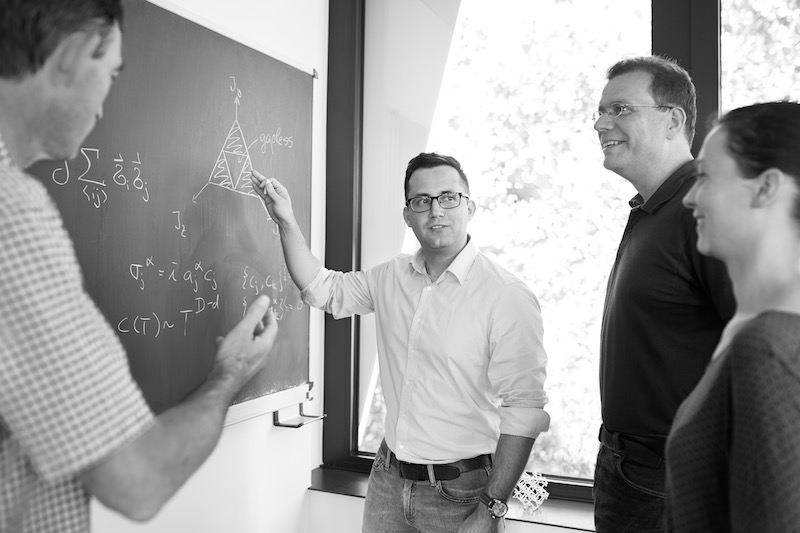
Research
Disclaimer: The content of this page is currently under revision and will be updated shortly.
Our group studies collective phenomena in quantum many-body systems that arise in the
presence of strong correlations. In our work we typically complement analytical approaches
by a variety of sophisticated numerical techniques that exploit concepts from statistical
physics, quantum information theory, and computer science.
The following sections give an overview of the major lines of our research in the past
3 to 5 years:
- Quantum spin liquids and Majorana metals
- Spin-orbit entanglement in Iridates
- Entanglement in quantum many-body systems
- Topological order and quantum criticality
- Open source codes for strongly correlated systems
Some of our long-term favorites:
Quantum spin liquids and Majorana metals
One of the most intriguing phenomena in strongly correlated systems is the fractionalization
of quantum numbers – familiar examples include the spin-charge separation in one-dimensional
metallic systems, the fractionalization of the electron in certain quantum Hall states or the
emergence of monopoles in spin ice.
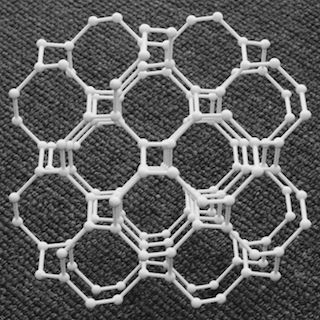 In this line of research, which is largely a collaboration with Maria Hermanns,
we investigate the fractionalization of magnetic moments in three-dimensional Kitaev models.
Our interest currently focuses on the collective behavior of the emergent Majorana fermionic degrees of freedom,
which form (semi)metallic states whose precise character turns out to intimately depend on the underlying lattice
structure.
For the two-dimensional honeycomb Kitaev model it is well known that the Majorana fermions form a semimetal
with two gapless Dirac points. For three-dimensional lattices (that preserve the tricoordination of the vertices)
one finds Majorana metals with a two-dimensional Fermi surface akin to a conventional metal [1],
states with nodal lines or even topological semimetals with Weyl nodes [2]. Going beyond the Kitaev
model and considering the effects of interactions between the Majoranas, we could show that some of these systems
generically undergo a spin-Peierls transition [3].
In this line of research, which is largely a collaboration with Maria Hermanns,
we investigate the fractionalization of magnetic moments in three-dimensional Kitaev models.
Our interest currently focuses on the collective behavior of the emergent Majorana fermionic degrees of freedom,
which form (semi)metallic states whose precise character turns out to intimately depend on the underlying lattice
structure.
For the two-dimensional honeycomb Kitaev model it is well known that the Majorana fermions form a semimetal
with two gapless Dirac points. For three-dimensional lattices (that preserve the tricoordination of the vertices)
one finds Majorana metals with a two-dimensional Fermi surface akin to a conventional metal [1],
states with nodal lines or even topological semimetals with Weyl nodes [2]. Going beyond the Kitaev
model and considering the effects of interactions between the Majoranas, we could show that some of these systems
generically undergo a spin-Peierls transition [3].
These 3D Kitaev models thus host an unusually rich variety of Z2 spin liquids that are all
analytically tractable. Discovering such spin liquid physics in an actual material should be a strong
motivation to study spin-orbit entangled Mott insulators such as the recently synthesized Iridate compounds
β-Li2IrO3 and γ-Li2IrO3, which potentially realize such
3D Kitaev models (see also the next section).
[1] Maria Hermanns and Simon Trebst, Phys. Rev. B 89, 235102 (2014).
[2] Maria Hermanns, Kevin O' Brien, and Simon Trebst, Phys. Rev. Lett. 114, 157202 (2015).
[3] Maria Hermanns, Simon Trebst, and Achim Rosch, Phys. Rev. Lett. 115, 177205 (2015).
[4] Kevin O' Brien, Maria Hermanns, and Simon Trebst, Phys. Rev. B 93, 085101 (2016).
Other resources
[5] Video and slides from a talk on Spin-Peierls Instabilities of 3D Kitaev Spin Liquids at KITP in fall 2015 [6] Slides from a talk on Majorana metals in spin-orbit entangled quantum matter given at the 2015 APS March Meeting
[7] Three-dimensional prints of these three-dimensional, tricoordinated lattices are available via shapeways.
[8] VESTA files for these three-dimensional, tricoordinated lattices: (10,3)a, (10,3)b, (10,3)c, (9,3)a, (8,3)a, (8,3)b, (8,3)c, (8,3)n
Spin-orbit entanglement in Iridates
The physics of transition metal oxides with partially filled
5d shells is governed by a largely accidental balance of electronic correlations, spin-orbit entanglement,
and crystal field effects, with all three components coming up roughly equal in strength.
With different materials exhibiting slight tilts towards one of the three effects a remarkably broad variety of
quantum states has recently been suggested.
A particularly intriguing scenario is the formation of Mott insulators in which the local moments are spin-orbit
entangled Kramers doublets. An example are the j=1/2 Mott insulators observed for a number of Iridates including
the layered materials Na2IrO3, α-Li2IrO3 (both hexagonal) and
Ba3IrTi2O9 (triangular), which
have been in the focus of our work.
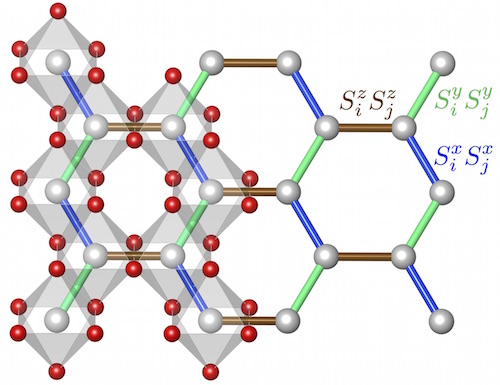 The microscopic exchange in these systems has been argued to be a combination of isotropic Heisenberg and highly anisotropic
Kitaev exchange, which can be tracked back to the spin and orbital components of the effective momenta.
Depending on the relative strength of these two couplings, the system exhibits either various types of
conventional magnetic order or a more exotic gapless spin-liquid ground state (see also the previous section).
Carefully studying the stability of these phases at finite-temperatures and the role of frustration,
The microscopic exchange in these systems has been argued to be a combination of isotropic Heisenberg and highly anisotropic
Kitaev exchange, which can be tracked back to the spin and orbital components of the effective momenta.
Depending on the relative strength of these two couplings, the system exhibits either various types of
conventional magnetic order or a more exotic gapless spin-liquid ground state (see also the previous section).
Carefully studying the stability of these phases at finite-temperatures and the role of frustration,
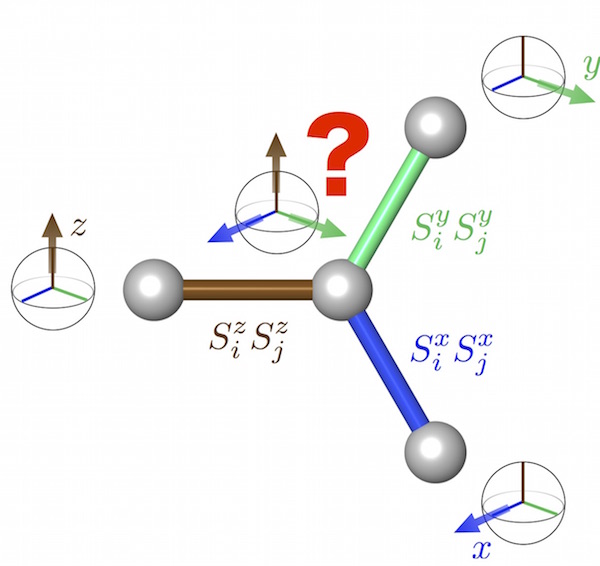 i.e. a considerable suppression of the ordering temperature from the Curie-Weiss temperature allowed us
to connect back to thermodynamic experiments on the Iridates (Na,Li)2IrO3 and
possibly estimate microscopic coupling parameters.
Finally, we discuss the effects of a magnetic field applied in the [111] direction – perpendicular to
the hexagonal lattice formed by the Iridium moments – and show that a topologically ordered ground state
is found over a small range of coupling parameters [5], also indicating the existence of an exotic critical
point whose location might not be far from actual material parameters.
i.e. a considerable suppression of the ordering temperature from the Curie-Weiss temperature allowed us
to connect back to thermodynamic experiments on the Iridates (Na,Li)2IrO3 and
possibly estimate microscopic coupling parameters.
Finally, we discuss the effects of a magnetic field applied in the [111] direction – perpendicular to
the hexagonal lattice formed by the Iridium moments – and show that a topologically ordered ground state
is found over a small range of coupling parameters [5], also indicating the existence of an exotic critical
point whose location might not be far from actual material parameters.
[1] M. Becker, M. Hermanns, B. Bauer, M. Garst, and S. Trebst, Phys. Rev. B 91, 155135 (2015).
[2] Eran Sela, Hong-Chen Jiang, Max H. Gerlach, and Simon Trebst, Phys. Rev. B 90, 035113 (2014).
[3] Y. Singh, S. Manni, J. Reuther, T. Berlijn, R. Thomale, W. Ku, S. Trebst, and P. Gegenwart, Phys. Rev. Lett. 108, 127203 (2012).
[4] J. Reuther, R. Thomale, and S. Trebst, Phys. Rev. B 84, 100406(R) (2011).
[5] Hong-Chen Jiang, Zheng-Cheng Gu, Xiao-Liang Qi, and Simon Trebst, Phys. Rev. B 83, 245104 (2011).
Other resources
[6] Overview article (with Kai Schmidt) on Topologische Spinflüssigkeiten in the April 2015 edition of the German Physik Journal
[7] News & Views article (with Philipp Gegenwart) on Kitaev matter in the May 2015 edition of Nature Physics
Entanglement in quantum many-body systems
References[1] Peter Broecker and Simon Trebst, J. Stat. Mech. P08015 (2014).
[2] Peter Broecker and Simon Trebst, Phys. Rev. B 94, 075144 (2016).
[3] Maria Hermanns and Simon Trebst, Phys. Rev. B 89, 205107 (2014).
[4] Johannes Helmes, Jean-Marie Stephan, and Simon Trebst, Phys. Rev. B 92, 125144 (2015).
Topological order and quantum criticality
Even in the absence of spontaneous symmetry breaking interacting quantum many-body systems can exhibit a phase transition into an ordered phase, albeit with an unusual form of non-local order typically refered to as topological order. We have been investigating various aspects of the quantum phase transitions that occur when such a system is driven out of the topologically ordered state by competing interactions, disorder or other sufficiently strong perturbations. Specific examples for these phase transitions occur in certain quantum spin models, which we have studied by extensive numerical simulations, and range from cases exhibiting well understood quantum critical behavior – including so-call conformal quantum critical points – to cases for which our numerics suggests quantum critical behavior, but which currently lack analytical understanding.
References[1] B. Bauer, L. Cincio, B. Keller, M. Dolfi, G. Vidal, S. Trebst, and A. Ludwig, Nature Comm. 5, 5137 (2014) and arXiv:1401.3017
[2] S.V. Isakov, P. Fendley, A.W.W. Ludwig, S. Trebst, and M. Troyer, Phys. Rev. B 83, 125114 (2011).
[3] C. Gils, S. Trebst, A. Kitaev, A. Ludwig, M. Troyer, and Z. Wang Nature Physics 5, 834 (2009) and arXiv:0906.1579
[4] Simon Trebst, Philipp Werner, Matthias Troyer, Kirill Shtengel, and Chetan Nayak, Phys. Rev. Lett. 98, 070602 (2007).
Other resources
[5] C. Castelnovo, S. Trebst, and M. Troyer, book chapter in "Understanding Quantum Phase Transitions" (Taylor and Francis, 2010)
Open source codes for strongly correlated systems
A major part of our research is devoted to the development, implementation, and application
of numerical methods for physical systems. Over the last years we have comprehensively used
and further improved various computational methods including several flavors of quantum and classical Monte Carlo
simulations, density matrix renormalization group calculations, exact diagonalization techniques,
and high-order strong coupling expansions. We implemented all these methods exploiting modern
programming techniques such as object-oriented programming in C++, generic algorithms, and parallelization
schemes.
We strive to facilitate the applicability of these numerical methods across disciplines such as
condensed matter theory, materials research, chemical engineering, and quantum information
processing.
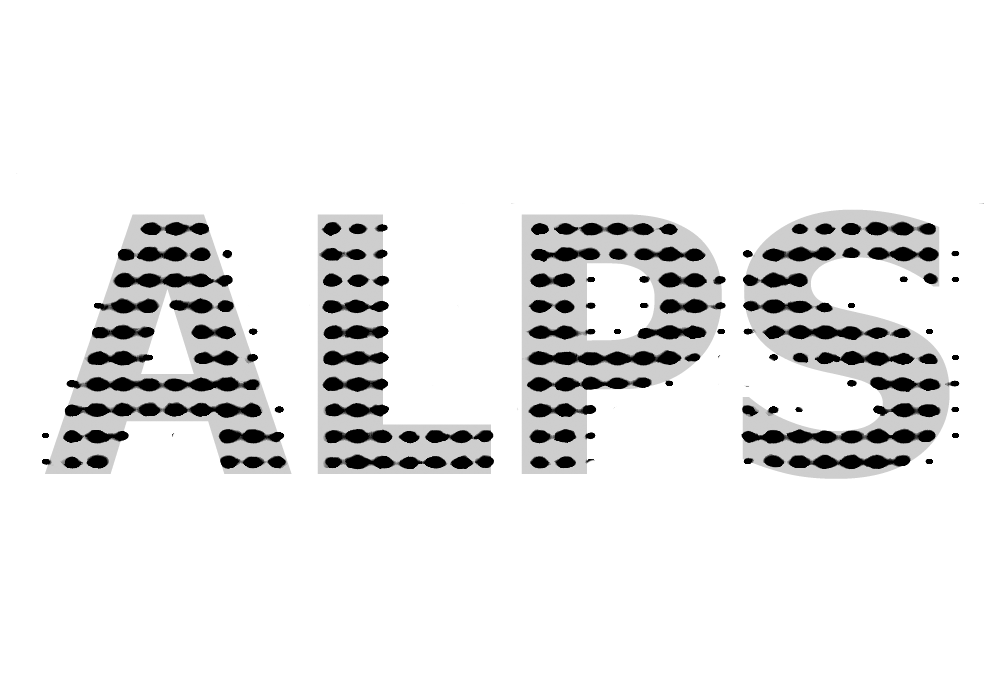 Unlike in other physics communities, there have been no high-performance "community codes"
available to study strongly correlated quantum systems. Driven by a common believe that
implementations of numerical methods should be publicly available to the physics community
as open source codes we have built a common framework to integrate and publish codes for numerical
simulations of strongly correlated systems and in 2003 launched the
ALPS project
(Algorithms and Libraries for Physics Simulations).
Today the ALPS project is maintained by an international collaboration
of researchers [1-4] and widely used by condensed matter theorists and experimentalists
around the globe.
Besides contributing implementations of several applications and basic libraries - most
notably the worm algorithm for continuous-time quantum Monte Carlo simulations
[5] - we have co-organized a series of workshops where the ALPS project was
founded. On the ALPS webpages you can find a description of our
ongoing and past
projects.
Unlike in other physics communities, there have been no high-performance "community codes"
available to study strongly correlated quantum systems. Driven by a common believe that
implementations of numerical methods should be publicly available to the physics community
as open source codes we have built a common framework to integrate and publish codes for numerical
simulations of strongly correlated systems and in 2003 launched the
ALPS project
(Algorithms and Libraries for Physics Simulations).
Today the ALPS project is maintained by an international collaboration
of researchers [1-4] and widely used by condensed matter theorists and experimentalists
around the globe.
Besides contributing implementations of several applications and basic libraries - most
notably the worm algorithm for continuous-time quantum Monte Carlo simulations
[5] - we have co-organized a series of workshops where the ALPS project was
founded. On the ALPS webpages you can find a description of our
ongoing and past
projects.
[1] F. Alet et al. (ALPS collaboration), J. Phys. Soc. Jpn. Suppl. 74, 30 (2005).
[2] A. F. Albuquerque et al. (ALPS collaboration), J. Magn. Mag. Mat. 310, 1187 (2007).
[3] B. Bauer et al. (ALPS collaboration), J. Stat. Mech. P05001 (2011).
Other resources
[4] Slides form a talk on The ALPS Project: Open Source Software for Quantum Lattice Models
[5] Slides form a talk on The worm algorithm
[6] Slides form a talk on Series expansions for Quantum Lattice Models
Interacting non-Abelian anyons
Topological quantum liquids, such as fractional quantum Hall liquids, rotating Bose-Einstein
condensates or px + ipy superconductors, harbor exotic quasiparticle
excitations, which due to their unusual exchange statistics are referred to as anyons.
A particularly intriguing species are non-Abelian anyons, which have attracted considerable
interest in proposals for topological quantum computation. Their defining characteristic
manifests itself when considering a set of non-Abelian anyons, which gives rise to a
(degenerate) manifold of states even when pinning the anyons to fixed locations in space.
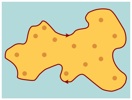 One line of my current research explores how this manifold of states for a set of
non-Abelian anyons is split in the presence of interactions between the anyons.
We could recently show that as a result of this splitting a single ground state is
selected [1].
This new collective state corresponds to a gapped quantum liquid nucleated within the
original parent liquid (of which the anyons are excitations) with characteristic (neutral)
edge states forming at the spatial interface between the two liquids. These edge states
are in precise correspondence with the gapless modes found for one-dimensional arrangements
of anyons, such as the "golden chain" [2] and variations thereof [3].
This physics is at play when tuning the magnetic field off the center of the plateau for
a non-Abelian quantum Hall state and will have direct experimental signatures,
such as modifications to the thermal heat transport.
One line of my current research explores how this manifold of states for a set of
non-Abelian anyons is split in the presence of interactions between the anyons.
We could recently show that as a result of this splitting a single ground state is
selected [1].
This new collective state corresponds to a gapped quantum liquid nucleated within the
original parent liquid (of which the anyons are excitations) with characteristic (neutral)
edge states forming at the spatial interface between the two liquids. These edge states
are in precise correspondence with the gapless modes found for one-dimensional arrangements
of anyons, such as the "golden chain" [2] and variations thereof [3].
This physics is at play when tuning the magnetic field off the center of the plateau for
a non-Abelian quantum Hall state and will have direct experimental signatures,
such as modifications to the thermal heat transport.
[1] A. Feiguin, S. Trebst, A. Ludwig, M. Troyer, A. Kitaev, Z. Wang, and M. Freedman, Phys. Rev. Lett. 98, 160409 (2007).
[2] S. Trebst, M. Troyer, Z. Wang and A.W.W. Ludwig, Prog. Theor. Phys. Suppl. 176, 384 (2008).
[3] S. Trebst, E. Ardonne, A. Feiguin, D. A. Huse, A. W. W. Ludwig, M. Troyer, Phys. Rev. Lett. 101, 050401 (2008).
[4] C. Gils, E. Ardonne, S. Trebst, A. W. W. Ludwig, M. Troyer, Z. Wang, Phys. Rev. Lett. 103, 070401 (2009).
[5] Eddy Ardonne, Jan Gukelberger, Andreas W.W. Ludwig, Simon Trebst, and Matthias Troyer, New J. Phys. 13, 045006 (2011).
[6] Andreas W.W. Ludwig, Didier Poilblanc, Simon Trebst, and Matthias Troyer, New J. Phys. 13, 045014 (2011).
[7] D. Poilblanc, A. Ludwig, S. Trebst, and M. Troyer, Phys. Rev. B 83, 134439 (2011).
[8] C.R. Laumann, D.A. Huse, A.W.W. Ludwig, G. Refael, S. Trebst, and M. Troyer, Phys. Rev. B 85, 224201 (2012).
[9] Chris R. Laumann, Andreas W.W. Ludwig, David A. Huse, and Simon Trebst, Phys. Rev. B 85, 161301(R) (2012).
[10] C. Gils, E. Ardonne, S. Trebst, D.A. Huse, A.W.W. Ludwig, M. Troyer, and Z. Wang, Phys. Rev. B 87, 235120 (2013).
Other resources
[11] Slides from a talk on Interactions and Disorder in Topological Quantum Matter
[12] Slides from a talk on Collective states of interacting anyons, edge states and the nucleation of topological liquids
[13] Slides from a talk on Interacting Anyons in Topological Quantum Liquids: The Golden Chain
[14] Video and slides from an overview talk at KITP from 2009.
Optimized statistical ensembles
Competing phases or interactions in complex many-particle systems can result in free
energy barriers that strongly suppress thermal equilibration. Prominent examples of slowly
equilibrating systems are frustrated magnets, glasses or proteins. To study the equilibrium
behavior of such systems we have developed
an adaptive Monte Carlo simulation technique that is capable to explore and overcome the
entropic barriers which cause the slow-down [1].
The algorithm systematically optimizes the simulated statistical ensemble in
broad-histogram Monte Carlo simulations by maximizing the round-trip rates between low and
high entropy states based on measurements of the local diffusivity. In contrast to
flat-histogram sampling techniques which recently have become very popular we demonstrated
that these optimized histogram methods do not suffer from a critical slowing down
[1,2].
In fact, for a number of applications we have shown that the simulation of an optimized
ensemble can speed up equilibration by orders of magnitude in systems which have long
relaxation times in conventional simulations such as low-energy configurations of
frustrated systems [1], Potts models (with up to 250 states) exhibiting
strong first-order transitions [3], dense Lennard-Jones liquids [4]
or quantum systems [5].
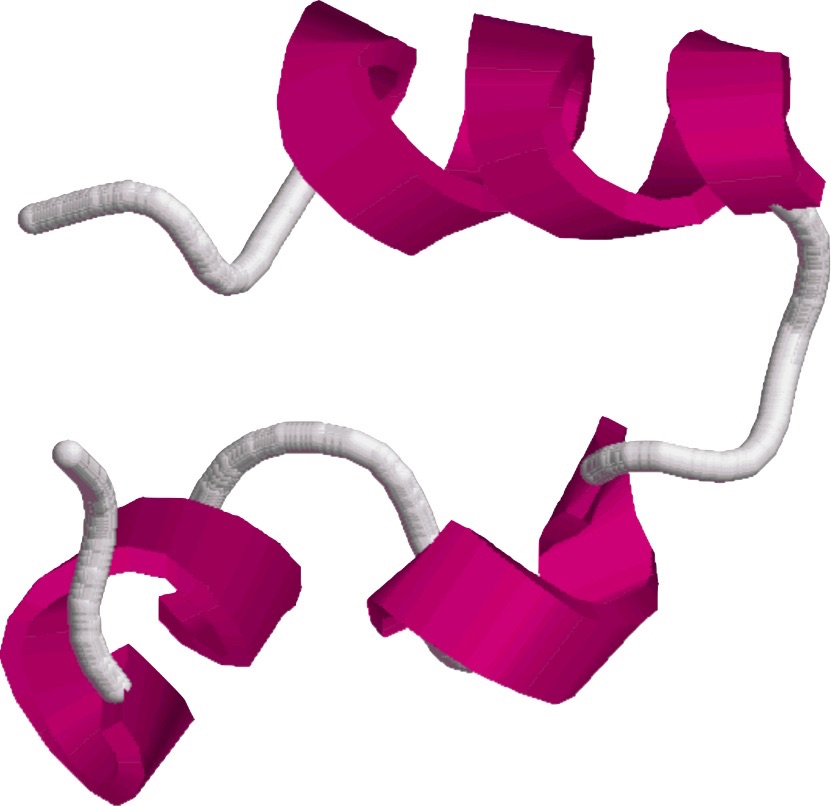 In an interdisciplinary project we applied this technique to study the folding of small proteins [6].
It turns out that the state-of-the-art parallel tempering algorithm for these systems can
be significantly improved by applying our novel approach to optimize the simulated
temperature/replica set [7].
The adaptive optimization thereby reveals the multiple temperature scales governing the
folding process of a single protein and systematically reallocates computational resources
to the bottlenecks in the transition.
In an interdisciplinary project we applied this technique to study the folding of small proteins [6].
It turns out that the state-of-the-art parallel tempering algorithm for these systems can
be significantly improved by applying our novel approach to optimize the simulated
temperature/replica set [7].
The adaptive optimization thereby reveals the multiple temperature scales governing the
folding process of a single protein and systematically reallocates computational resources
to the bottlenecks in the transition.
Our new algorithms have been met with some enthusiasm by the broader numerical community
and are now employed in a variety of fields beyond condensed matter physics, including
biological physics, chemical engineering, high-energy physics and probabilistic optimization.
For a short introductory review of the ensemble optimization techniques see references
[8,9].
[1] Simon Trebst, David A. Huse, Matthias Troyer, Phys. Rev. E 70, 046701 (2004).
[2] P. Dayal, S. Trebst, S. Wessel, D. Würtz, M. Troyer, S. Sabhapandit, S. N. Coppersmith, Phys. Rev. Lett. 92, 097201 (2004).
[3] Bela Bauer, Emanuel Gull, Simon Trebst, Matthias Troyer, and David A. Huse, J. Stat. Mech. P01020 (2010).
[4] Simon Trebst, Emanuel Gull, Matthias Troyer, J. Chem. Phys. 123, 204501 (2005).
[5] S. Wessel, N. Stoop, E. Gull, S. Trebst, M. Troyer, J. Stat. Mech. P12005 (2007).
[6] Simon Trebst, Matthias Troyer, Ulrich H. E. Hansmann, J. Chem. Phys. 124, 174903 (2006).
[7] H.G. Katzgraber, S. Trebst, D.A. Huse, M. Troyer, J. Stat. Mech. P03018 (2006).
[8] S. Trebst et al., Springer Proceedings in Physics 123, 33 (2008).
Other resources
[9] Video and lecture notes of an overview talk on Extended statistical ensembles given at the 2010 Boulder Summer School
[10] Slides from a review talk on Optimized statistical ensembles